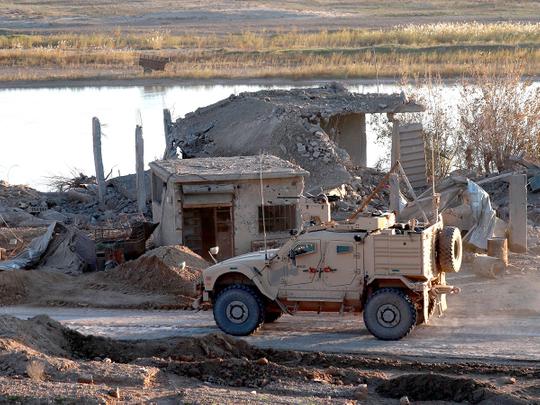
How it started
In September 2014, the then president of the United States, Barack Obama, launched an air campaign against Daesh in Syria, one month after starting air strikes in neighbouring Iraq. Daesh had built substantial military firepower in Syria, which it used to sweep across western and northern Iraq earlier in 2014.
In late 2015, the first American ground troops entered Syria — initially 50, growing to the current official total of about 2,000. They recruited, organised and advised thousands of Syrian Kurdish and Arab fighters, dubbed the Syrian Democratic Forces, and pushed Daesh out of most of its strongholds.
Military operations
To date, the US-led coalition has launched air strikes on at least 17,000 locations in Syria since the start of the operation. Last week, there were strikes on 208 locations, largely on Daesh fighters and facilities in the Middle Euphrates River Valley (Merv), according to the US military.
Thousands of Daesh fighters have been killed or captured, but US military officials say there are still as many at 2,000 insurgents still in the Merv, and a number of others who have escaped to various locations around the country.
Complications
Russia joined the big-power entanglement in Syria in the autumn of 2015. Moscow said it was there to defeat terrorists, but Washington objected, saying the Russian military was propping up Syrian President Bashar Al Assad and making it more difficult to eliminate Daesh. To avoid aerial confrontations and accidents, US and Russian military officials set up a telephone “deconfliction line”, which remains in effect.
Turkey’s concern about links between the US-supported Syrian Kurdish militias and Kurdish insurgents inside Turkey added a further complication for Washington. The Turkish military intervened in northern Syria, prompting the Syrian Kurds to temporarily abandon the fight against Daesh.
Iran has also maintained a presence in the country, supporting Al Assad and supplying weapons, the US has asserted.
Reactions
The decision has been met with widespread condemnation and only a smattering of support.
Pentagon leaders were largely mum on Wednesday, adhering to the mandate that US civilian leaders make policy and the military salutes and moves forward. But top defence officials have been blunt in recent assessments, confirming that the fight against Daesh is not over yet.
Brett McGurk, the administration’s envoy for the fight against Daesh, had said on December 11: “It would be reckless if we were just to say, well, the physical ‘caliphate’ is defeated, so we can just leave now. I think anyone who’s looked at a conflict like this would agree with that.”
Senator Marco Rubio, a Florida Republican, called the pullout “catastrophic”, while Senator Lindsey Graham, a Republican from South Carolina, deemed it a “disaster in the making”.
Senator Jeanne Shaheen, a Democrat from New Hampshire, said an ill-informed and hasty withdrawal may breathe new life into Daesh and other insurgent groups, and “will also cede America’s hard-fought gains in the region to Russia, Iran and Al Assad”.








